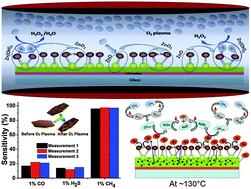Functionalized ZnO/ZnO2 n–N straddling heterostructure achieved by oxygen plasma bombardment for highly selective methane sensing
Abstract
Metal oxide semiconductors have been extensively used as reducing gas sensors with major limitations regarding selectivity and operating temperature which is relatively high for most of the cases making the device unusable in some critical situations. Higher operating temperature is also associated with the higher power consumption, which goes against the miniaturization of the device. In order to resolve these problems, here we introduced a ZnO/ZnO2 straddling ‘n–N’ isotype heterostructure as a highly selective and sensitive methane sensor at moderately low operating temperature. ZnO–Zn(OH)2 precursor films were treated in oxygen plasma in a pulsed DC magnetron sputtering system. Morphological analyses by field emission scanning electron microscopy showed flake like growth of the grains with high surface roughness, whereas X-ray diffraction (XRD) showed polycrystalline nature of the films. Polycrystalline ZnO2 peaks were observed in the XRD pattern in addition to the existing ZnO, which indicates modification of the precursor to oxygen rich heterostructure of ZnO/ZnO2. This was further supported by the shifting of the O1s peak in the X-ray photoelectron spectroscopic analysis. Plasma treated ZnO/ZnO2 heterostructured films were found to show high selectivity towards methane (with respect to H2S and CO) and sensitivity (∼96%) at a comparatively low operating temperature.


 Please wait while we load your content...
Please wait while we load your content...